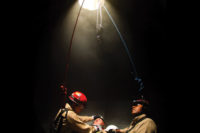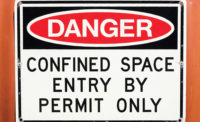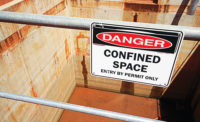Permit-required confined spaces are found in many workplaces and are very hazardous to employees that must enter them. What makes them so dangerous is that permit spaces have one or more of the following characteristics:
- Contains or has the potential to contain a hazardous atmosphere;
- Contains material that has the potential to engulf an entrant;
- Has walls that converge inward or floors that slope downward and taper into a smaller area which could trap or asphyxiate an entrant; or
- Contains any other recognized safety or health hazard, such as unguarded machinery, exposed live wires, or heat stress.
OSHA requires employers to protect workers from the hazards of entry into permit spaces. One important way to do this is to ensure the entry team understands their duties.
The entry team is made up of three distinct roles — authorized entrant, attendant, and entry supervisor.
Authorized entrant
An authorized entrant is the employee who is authorized by the employer to enter a permit space.
Employers have the responsibility to make sure authorized entrants:
- Know the hazards that may be faced during entry, including information on the mode, signs or symptoms, and consequences of the exposure.
- Properly use the following equipment:
- Testing and monitoring equipment,
- Ventilating equipment,
- Communications equipment,
- Personal protective equipment,
- Lighting equipment,
- Barriers and shields,
- Ladders,
- Rescue and emergency equipment, and
- Other equipment necessary for safe entry into and rescue from permit spaces.
- Communicate with the attendant in order to monitor entrant status and to evacuate the space as needed.
Alert the attendant whenever:
The entrant recognizes any warning sign or symptom of exposure to a dangerous situation, or
tThe entrant detects a prohibited condition.
Exit from the permit space whenever:
- An order to evacuate is given by the attendant or the entry supervisor,
- The entrant recognizes any warning sign or symptom of exposure to a dangerous situation,
- The entrant detects a prohibited condition, or
- An evacuation alarm is activated.
Attendant
The attendant is the individual stationed outside one or more permit spaces who:
- Monitors the authorized entrants, and
- Performs all assigned attendant’s duties.
Attendants have the following duties:
Be familiar with known and potential hazards during entry, including how exposure can happen, along with any signs, symptoms, and effects.
Know the behavioral effects hazard exposure can cause in authorized entrants. Slurred speech or a delay in response time are both signals something could be wrong.
Keep track of how many authorized entrants are in the permit space and who those entrants are.
Remain outside of the permit space until entry operations are complete or until they’re relieved by another trained attendant.
Maintain communication with the authorized entrant and be prepared to order the authorized entrant to leave the permit-required confined space if an unsafe condition arises.
Monitor activities both inside and outside the permit space to determine if it is safe for authorized entrants to stay and complete their tasks.
Order an entrant to evacuate immediately if:
- They detect a prohibited condition,
- They notice a change in the entrant’s behavior caused by hazard exposure,
- There is a situation outside the space that could endanger the entrant, or
- The attendant cannot effectively and safely perform all their duties.
- Summon rescue or emergency services when they believe an entrant will need assistance to escape from permit space hazards.
Keep unauthorized persons that approach or enter a permit space during entry operations away by:
- Warning them to stay away from the permit space,
- Telling them to exit immediately if they entered the permit space, and
- Informing the authorized entrants and the entry supervisor that unauthorized personnel have entered the permit space.
- Perform non-entry rescues as specified by their employer’s rescue procedure.
Attendants must not perform any additional duties that might interfere with their primary duty to monitor and protect the authorized entrants.
Relieved attendants may enter the permit space to attempt a rescue if the employer’s permit space program allows attendant entry for rescue. Another attendant must be outside the space and the relieved attendant must be properly trained and equipped for rescue operations.
Entry supervisor
The entry supervisor is responsible for determining if acceptable entry conditions are present at a permit space where entry is planned, for authorizing entry and overseeing entry operations, and for terminating entry.
The entry supervisor must:
Be familiar with known and potential hazards inside the permit space, as well as the signs, symptoms, and effects hazard exposure may cause.
Allow entry into the permit space after verification of the following information:
- Appropriate information has been entered on the permit,
- All tests specified by the permit have been conducted, and
- All procedures and equipment specified by the permit are in place.
Only after verification, will the entry supervisor sign the permit and allow entry operations to begin.
The entry supervisor terminates entry and cancels the entry permit after all tasks in the space (entry operations) have been completed or a condition that is not allowed under the entry permit arises in or near the permit space.
The entry supervisor needs to verify that rescue services are available and that the
equipment (cellphone, radio, etc.) used to contact them is working.
The entry supervisor is responsible for removing unauthorized individuals who enter or attempt to enter the permit space during entry operations.
The entry supervisor needs to determine that acceptable entry conditions are maintained throughout the entry by checking at appropriate intervals and whenever the responsibility for the entry operation is transferred to another entry supervisor.
An entry supervisor also may serve as an attendant or as an authorized entrant, if they are trained and equipped to do so.
The duties of an entry supervisor can be passed from one individual to another during an entry operation.
Take away
When the permit space entry team (authorized entrant, attendant, and entry supervisor) performs their required duties, employers can be sure the permit space entry will be done efficiently, and more important, done safely.







